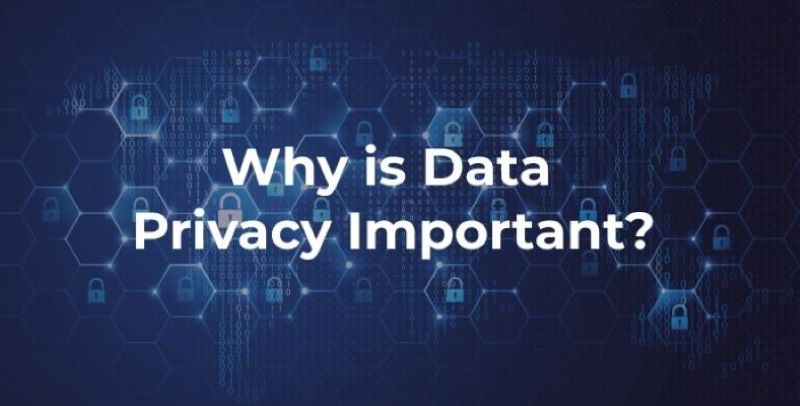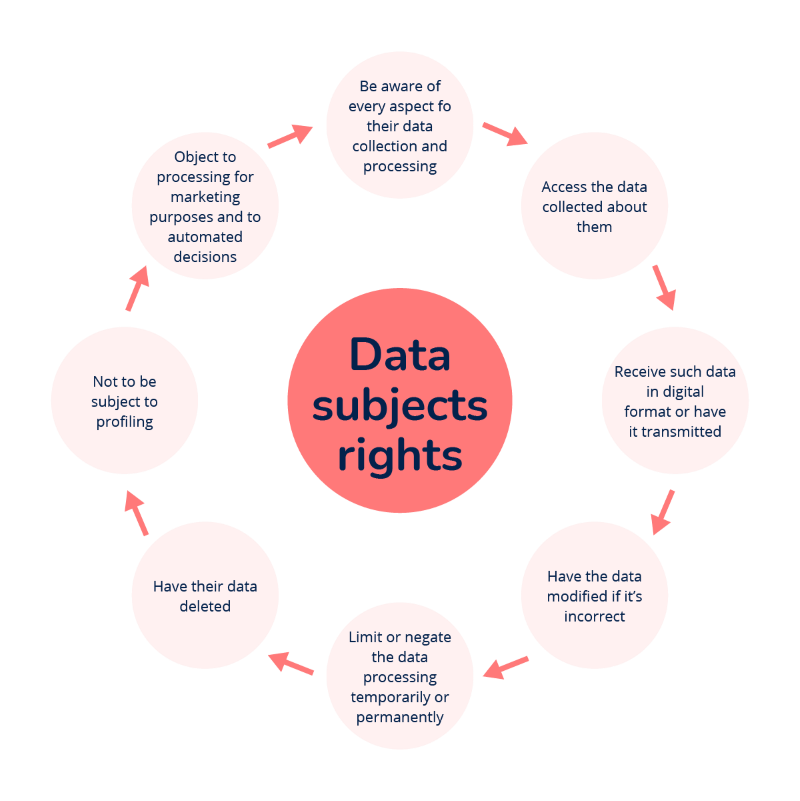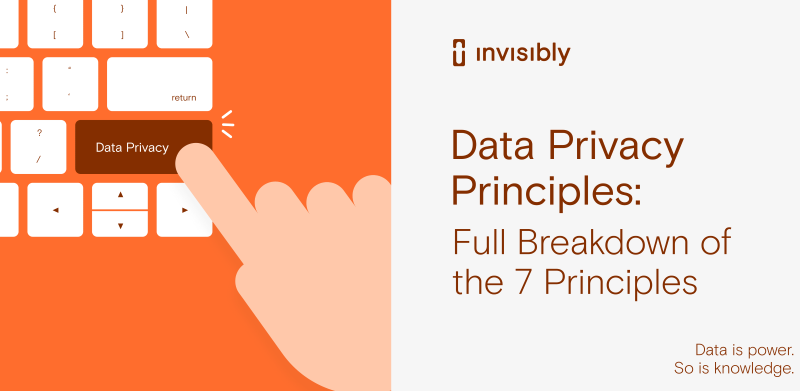Protecting personal data is paramount in today’s digital era. Adhering to the 3 data privacy principles of transparency, accountability, and security is essential for safeguarding individuals’ sensitive information in an increasingly interconnected world.
Why are the Data protection principles important?
The Data Protection Principles are crucial for several reasons, primarily centered around ensuring privacy, building trust, and maintaining the integrity of personal data. Here are key reasons why these principles are essential:
Privacy Protection
Data protection principles help safeguard individuals’ personal information from misuse, unauthorized access, and breaches. This protection is fundamental to maintaining privacy in an increasingly digital world where data is constantly collected and processed.
Trust and Confidence
Adhering to data protection principles fosters trust between organizations and their customers or users. When individuals know their data is handled responsibly and ethically, they are more likely to engage with and trust the organization.
Legal Compliance
Many countries have enacted laws and regulations that mandate adherence to specific data protection principles. Compliance with these principles ensures that organizations operate within the legal framework, avoiding potential fines, sanctions, or legal actions.

Risk Management
Implementing data protection principles helps organizations identify and mitigate data breaches, unauthorized access, and data misuse risks. Effective risk management minimizes potential damage and ensures business continuity.
Data Accuracy and Quality
Data protection principles emphasize the importance of data accuracy and relevance. Ensuring that personal data is accurate, up-to-date, and relevant enhances its quality and usefulness for the organization and the individuals concerned.
Transparency and Accountability
These principles promote transparency about collecting, using, and sharing personal data. They also hold organizations accountable for their data handling practices, requiring them to be open and honest about their data protection measures.
Ethical Data Handling
Adhering to data protection principles encourages ethical practices in data handling. Organizations are guided to respect individuals’ rights and freedoms, ensuring that data processing activities do not harm individuals.
Empowerment of Individuals
Data protection principles, such as the right to access, rectify, or delete personal data, empower individuals to take control of their information. This empowerment is crucial for protecting personal autonomy and freedom in the digital age.
Enhanced Security Measures
The principles often include requirements for implementing appropriate security measures to protect personal data. This emphasis on security helps prevent data breaches and protects sensitive information from cyber threats.
Global Interoperability
As data flows across borders, adhering to widely recognized data protection principles facilitates international data transfers. This interoperability is essential for global business operations and ensures data protection standards are met across jurisdictions.
Data protection principles are essential for protecting individuals’ privacy, building trust, ensuring legal compliance, managing risks, and promoting ethical data-handling practices. They form the foundation for a responsible and secure approach to managing personal data in today’s interconnected world.

3 data privacy principles
Protecting personal information requires adherence to the legality, fairness, and transparency trio – 3 data privacy principles that ensure strong safeguards..
Fairness, Legal compliance, and transparency
Legal compliance in data privacy refers to adhering to relevant laws, regulations, and standards governing personal information collection, processing, and storage. This includes rules such as the General Data Protection Regulation (GDPR) in the European Union and the California Consumer Privacy Act (CCPA) in the United States. By complying with these legal requirements, organizations ensure they lawfully handle personal data, protecting individuals’ rights and minimizing the risk of legal consequences.
Fairness in data privacy involves treating individuals’ personal information equally and impartially. Organizations collect and process data fairly and equitably to all individuals, without discrimination or bias. Fairness also encompasses providing individuals with transparency about how their data will be used and giving them control over their personal information. This ensures data processing activities are conducted ethically and respects individuals’ rights and expectations.
Transparency in data privacy refers to openness and clarity in how organizations collect, use, and share personal information. It involves providing clear and easily understandable information to individuals about data processing practices, including the purposes of data collection, the types of data being collected, and the rights individuals have regarding their data. Transparency also entails being upfront about any potential risks or consequences associated with data processing activities. By openness, organizations build trust with individuals and demonstrate accountability for their data-handling practices.

Specific and limited purposes
The principle of specific and limited purposes in data privacy emphasizes that organizations should only collect, process, and use personal data for clearly defined and lawful purposes. This means that data should not be collected indiscriminately or used for purposes beyond what was initially specified at the time of collection. Instead, organizations should identify and document the specific purposes for which they intend to use personal data and ensure that they are legitimate, relevant, and necessary for their business activities or other lawful reasons.
By adhering to the principle of specific and limited purposes, organizations minimize the risk of misuse or unauthorized access to personal data. It also helps promote transparency and accountability by ensuring that individuals are informed about the purposes for which their data is being used and can exercise their rights to control how their data is processed.
For example, when collecting personal data for marketing purposes, an organization should specify that the data will be used for marketing activities such as sending promotional emails or targeted advertisements. Using the data for other purposes, such as selling it to third parties or analyzing it for unrelated research, would violate the individual’s principle of specific and limited purposes unless explicitly consented to.

Rights of data subjects
The rights of data subjects are fundamental principles in data privacy that aim to empower individuals to control their data and protect their privacy. These rights are commonly embedded in data protection legislation worldwide, including the General Data Protection Regulation (GDPR) in the European Union and the California Consumer Privacy Act (CCPA) in the United States. Among the fundamental entitlements of data subjects are:
Right to Access: Individuals are entitled to request access to the data held by organizations.
Right to Rectification: Data subjects can request the correction or updating of inaccurate or incomplete personal data held by organizations. This ensures that individuals’ data is accurate and up-to-date.
Right to Erasure (Right to be Forgotten): Under certain circumstances, individuals have the right to request the deletion or removal of their data from an organization’s systems. This right allows individuals to have their data erased when it is no longer necessary for the purposes for which it was collected or when they withdraw their consent for processing.
Right to Data Portability: Data subjects can take their data in a structured, commonly used, and machine-readable format and transmit it to another organization without hindrance. This right enables individuals to move, copy, or transfer data between service providers or platforms.
Right to Limit Processing: Under specific circumstances, data subjects are entitled to request limitations on processing their data.
Right to Restriction of Processing: Under certain circumstances, data subjects have the right to request the restriction of the processing of their data.
Right to Object to Automated Decision-Making: Individuals maintain the right to protest decisions made solely through automated processing, including profiling, if such determinations significantly impact them.

Other data privacy principles
Data Minimization
Principle: Collect only the data that is strictly necessary for the purpose it is being processed.
Explanation: This principle ensures that organizations refrain from gathering excessive data. Limiting data collection to what is needed reduces data breaches or misuse risks.
Accountability
Principle: Organizations must take responsibility for complying with data protection principles and be able to demonstrate this compliance.
Explanation: Organizations must implement appropriate measures and be prepared to demonstrate their data protection practices to regulators. This can include documentation, data protection policies, and impact assessments.
Purpose Limitation
Principle: Data should be collected for specified, explicit, and legitimate purposes and not further processed in an incompatible manner.
Explanation: This ensures that personal data is not reused or repurposed without consent. Further consent or legal basis must be obtained if data is needed for a new purpose.
Accuracy
Principle: Ensure that personal data is accurate and, where necessary, kept up to date.
Explanation: Organizations must take reasonable steps to correct or delete inaccurate data. This helps maintain data integrity and avoid potential harm caused by incorrect information.
Integrity and Confidentiality
Principle: Personal data must be processed in a manner that ensures appropriate security, including protection against unauthorized or unlawful processing and accidental loss, destruction, or damage.
Explanation: This involves implementing technical and organizational measures to protect data, such as encryption, access controls, and regular security assessments.
Storage Limitations
Principle: Personal data should be kept in a form that permits identification of data subjects for no longer than is necessary for the purposes for which the personal data is processed.
Explanation: Organizations should establish retention policies and regularly review the data they hold, ensuring it is deleted or anonymized when it is no longer needed.

Benefits of adhering to 3 data privacy principles
Protect users’ rights.
Protecting users’ rights is a core principle in data privacy that emphasizes the importance of safeguarding individuals’ privacy and ensuring that their data is handled legally, fairly, and transparently. There are several key ways in which organizations can protect users’ rights in the context of data privacy:
- Transparency: Organizations should be transparent about their data collection, processing, and usage practices. This includes providing clear and easily understandable information to users about what personal data is being collected, how it will be used, and with whom it will be shared.
- Consent: Organizations must acquire explicit consent from users before collecting, processing, or sharing their data
- Purpose Limitation: Organizations should only collect and process personal data for specified, explicit, and legitimate purposes and should not use the data for incompatible purposes.
- Data Minimization: Organizations should only collect and retain personal data necessary for the purposes it is being processed. They should also ensure that the data is accurate, up-to-date, and relevant to those purposes.
- Security: Organizations should implement appropriate technical and organizational measures to protect users’ data against unauthorized access, disclosure, alteration, or destruction. This involves encrypting sensitive data, establishing access controls, and monitoring regular security breaches.
- User Rights: Organizations should respect and facilitate the exercise of users’ rights, such as access, rectification, erasure, and data portability. They should provide users with easy-to-use mechanisms for submitting data privacy requests and should respond to such requests promptly and transparently.
- Accountability: Organizations should be accountable for their data privacy practices and should demonstrate compliance with applicable data protection laws and regulations. This involves designating a data protection officer, performing privacy impact assessments, and keeping records of data processing activities.

Promote the reputation of the enterprise
Enhancing an organization’s reputation in 3 data privacy principles involves committing to protecting users’ privacy and personal data. Here are some critical steps an organization can take to enhance its reputation in this regard:
Compliance with Laws and Regulations: Ensure compliance with relevant data protection laws and regulations, such as the General Data Protection Regulation (GDPR), California Consumer Privacy Act (CCPA), and other applicable privacy statutes. This demonstrates the organization’s commitment to upholding legal standards for data privacy.
Transparent Data Practices: Be transparent about data collection, processing, and usage practices. Provide clear and easily understandable privacy policies that explain how personal data is collected, used, shared, and protected. Transparency builds trust with users and demonstrates a commitment to openness and accountability.
Strong Security Measures: Implement robust security measures to protect users’ data against unauthorized access, disclosure, alteration, and destruction. This involves employing encryption, implementing access controls, conducting routine security assessments, and providing employee training on best practices for data security.
Privacy by Design: Integrate privacy considerations into the design and development process of products, services, and systems from the outset.
User Consent and Control: Obtain explicit consent before collecting, processing, or sharing their data. Provide users with meaningful choices and controls over their data, including the ability to access, correct, delete, or export their data as required by law.
Accountability and Governance: Establish precise accountability mechanisms for data privacy within the organization. Appoint a dedicated data protection officer (DPO) or privacy team responsible for compliance with data protection laws and regulations. Conduct regular privacy assessments and audits to identify and address potential privacy risks.
Responsiveness and Communication: Respond promptly and transparently to user inquiries, complaints, and data privacy requests. Communicate openly about privacy incidents, data breaches, or changes to privacy practices, and take appropriate remedial actions to mitigate harm and restore trust.

Minimize legal risks
Minimizing legal risks in 3 data privacy principles involves ensuring compliance with applicable laws and regulations while implementing proactive measures to mitigate potential liabilities. Below are some approaches to accomplish this:
Understand and Comply with Regulations: Stay informed about relevant data protection laws and regulations, such as the GDPR, CCPA, and other regional or industry-specific laws. Conduct regular audits to assess compliance with legal requirements and update policies and procedures accordingly.
Implement Privacy by Design: Incorporate privacy considerations into the design and development of products, services, and systems from the outset. Adhere to data minimization, purpose limitation, and user consent to reduce the risk of non-compliance with privacy laws.
Obtain Explicit Consent: Obtain explicit consent from users before collecting, processing, or sharing their data. Ensure that consent is freely given, specific, informed, and unambiguous, and provide users with clear options to opt in or out of data processing activities.
Secure Data Handling Practices: Implement robust security measures to protect personal data against unauthorized access, disclosure, alteration, or destruction. This includes encryption, access controls, regular security assessments, and employee training on data security best practices.
Conduct Privacy Impact Assessments (PIAs): Conduct PIAs to identify and assess potential privacy risks associated with new projects, products, or data processing activities. Implement measures to mitigate identified risks and ensure compliance with legal requirements.
Maintain Data Accuracy and Integrity: Ensure that personal data is accurate, up-to-date, and relevant for the purposes for which it is processed. Establish data validation, rectification, and deletion procedures to minimize the risk of legal liabilities arising from inaccurate or outdated data.

Application of 3 Data Privacy Principles
Data privacy principles are applied through organizational policies, technical measures, and operational practices. Here’s how they are typically implemented:
Policy Development: Organizations establish comprehensive data privacy policies that outline how personal data will be collected, processed, stored, and shared. These policies are aligned with applicable laws and regulations and often include provisions for obtaining user consent, handling data breaches, and ensuring data security.
Data Inventory and Classification: Organizations thoroughly inventory the personal data they collect and maintain. They classify this data based on its sensitivity and risk level, ensuring that appropriate safeguards are implemented to protect it
Consent Management: Organizations obtain explicit consent from individuals before collecting, processing, or sharing their data. They provide clear and transparent information about data processing purposes and offer mechanisms for users to withdraw their consent if desired.
Data Minimization: Organizations are advised to collect and retain only the personal data essential for processing purposes.
Security Measures: Organizations implement robust technical and organizational security measures to protect personal data from unauthorized access, disclosure, alteration, or destruction. This may include encryption, access controls, regular security audits, and employee training on data security best practices.
Privacy by Design and Default: Organizations incorporate privacy considerations into the design and development of products, services, and systems from the outset. They implement privacy-enhancing technologies and practices to maintain user privacy by default.
Data Subject Rights Management: Organizations establish procedures for facilitating data subject rights, such as access, rectification, erasure, and data portability. They provide user-friendly mechanisms for individuals to submit data privacy requests and ensure prompt and transparent responses to such requests.
Examples of the Data Protection Principles in Action
Data protection principles are implemented through various practices and policies across organizations and jurisdictions. Here are some concrete examples of these principles in action:
Lawfulness, fairness, and transparency
- Example: An e-commerce company provides a clear privacy policy on its website, explaining how customer data is collected, used, and shared. The policy is plain language to ensure customers understand their data practices.
Purpose limitation
- Example: A healthcare provider collects patient information for treatment and billing purposes. They do not use this data without explicit patient consent for marketing or other unrelated activities.
Data minimization
- Example: A social media platform only asks users for the minimum necessary information required to create an account, such as name and email address, avoiding unnecessary data collection like home addresses or phone numbers.
Accuracy
- Example: A bank regularly updates its customer records and provides customers with online access to their personal information, allowing them to review and correct any inaccuracies in their data.
Storage limitation
- Example: An online retailer retains transaction data only as long as necessary to fulfill orders and comply with legal obligations (e.g., tax records), then securely deletes the data after the retention period expires.
Integrity and confidentiality (Security)
- Example: A tech company employs encryption for data at rest and in transit, uses multi-factor authentication for user access, and conducts regular security audits to protect personal data from breaches and unauthorized access.
Accountability
- Example: An international corporation appoints a Data Protection Officer (DPO) to oversee compliance with data protection laws, implements training programs for employees on data protection best practices, and conducts regular data protection impact assessments (DPIAs).
Individual rights
- Right of access:
- Example: A financial institution allows customers to request and receive a copy of all personal data about them within a specified timeframe, usually 30 days.
- Right to rectification:
- Example: An online service allows users to easily update their details, such as contact information or payment methods, through their account settings.
- Right to erasure (Right to be Forgotten):
- Example: A social networking site lets users delete their accounts and permanently remove all associated personal data from their servers.
- Right to data portability:
- Example: A cloud storage service provides users with tools to download their data in a structured, commonly used, and machine-readable format, facilitating easy transfer to another service provider.
- Right to object:
- Example: A marketing company offers an easy opt-out mechanism for users to withdraw consent from receiving promotional emails or being included in data profiling activities.
Privacy by design and default
- Example: A mobile app developer incorporates privacy features from the initial design phase, such as defaulting location tracking to ‘off’ and requiring explicit user consent to activate it, ensuring that the app respects user privacy from the outset.
International transfers
- Example: A multinational organization complies with international data transfer regulations, such as the EU-U.S. Data Privacy Framework, to protect personal data transferred between the EU and the U.S..
Consent
- Example: An online survey platform requires users to explicitly opt-in before collecting any data, providing clear information about what data will be collected, how it will be used, and obtaining consent through affirmative action, such as checking a box.
These examples demonstrate how data protection principles are translated into practical measures, policies, and tools that help protect personal data and respect individuals’ rights in various contexts.
Finally, the human factor remains a significant challenge in data privacy protection. Insider threats, human error, and inadequate training and awareness can compromise data security and privacy, highlighting the importance of organizational culture, education, and ongoing training initiatives.
The 3 data privacy principles are essential for preserving individuals’ privacy rights. For further insights, access the website Proxy Rotating to provide additional information. Together, these principles establish a foundation for fostering trust and integrity in the digital realm.
>> See more:
Data privacy evaluates moral problems related to data
